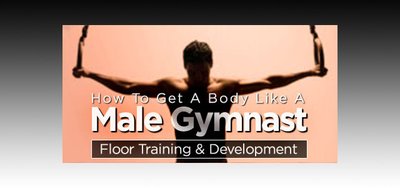With the Olympics rapidly approaching, many people are going to start tuning in and seeing what their favorite athletes bring to the table this time around. The summer Olympics feature popular sports such as track, gymnastics, and swimming, which require great degrees of athleticism and strength.
Gymnasts in particular, demonstrate not only strength, but balance, coordination and extreme amounts of flexibility.
For many of those out there in the bodybuilding field, the body of a gymnast is highly coveted.
The interesting thing about this though is that many gymnasts never so much as touch a weight machine during their training. If this is the case, just how do they develop the muscle they show to such a high extent?
Small Frames
The first thing to think about when considering the gymnast's body is the type of frame they have. How often do you see a 6-foot tall gymnast? Not often. Most are on the shorter side, hence they will require less muscle mass to have that fuller look.
It only makes sense that the longer your limbs are, the greater the diameter of the muscle tissue will have to be, since it'll be stretched out over the entire length of the bone.
The Development Of Power
Next, consider the types of movements these athletes are performing. Most are powerful in nature. They do handsprings, pull-up actions that hoist themselves into the air, mid-air tucks and springs off beams and boards.
This power will force them to work their fast-twitch muscles in a sprint-like capacity. If you've read up at all on the various cardio methods, which one is most often associated with maximum fat loss? Sprinting.
Therefore, combine their shorter body stature with a lot of sprint-like activity which allows them to get down to low body fat levels, and it should be clear that both factors greatly work in their favor to enhance their appearance.
Some of them are not even all that muscular, they just have low body fat levels and good muscle pumps.
Time Span
Also, keep in mind that these gymnasts develop this muscle mass over years. Most start to train when they are at the tender age of 8-12, giving them ten years to put on the muscle mass seen in these athletes. If they are even gaining muscle at a rate of 4-5 pounds a year, this really pales in comparison to what most bodybuilder's try and achieve—at 1-2 pounds per month.
Obviously muscle growth won't happen at any significant rate when gymnasts are only 10-years old, but they are still priming their body for training.
Furthermore, most don't actually weigh all that much (usually between 140-170 pounds) and so again, they don't have significantly huge volumes of muscle on their frame.
The Type Of Training They Do
Now, when thinking about their training specifically, gymnasts perform a great deal of bodyweight exercises, which will work deep into the muscle fibers, due to the instability factor that's thrown in.
As stated above, they are performing pull-ups, handstand push-ups, isometric holds, and some will complete leg extensions and hamstring curls as well to work the leg muscles further.
They also train for very long hours. It's not unusual for Olympic level gymnasts to spend 4-6 hours training each day.
Here is a sample of a floor workout a gymnast might perform (done for 2-3 sets of each exercise):
Sample Exercises
- Push-ups
- Hanging Leg Raise
- Bench Dips
- Freehand Jump Squat
- Dumbbell Step-ups
- Chin-ups
- Hyperextensions (back extensions)
- Side Lateral Raise
- Standing Long Jump
- Plyo Kettlebell Push-ups
Keep in mind that in addition to these exercises, the gymnasts will also do a high volume of training for whatever event they happen to be working on during that session. This could be the rings, the balance beam, the parallel bars, the floor and so on.
Applying These Principles To Your Workout
So, to apply these principles to your program, start considering adding in more plyometric and bodyweight exercises.
If there is one thing these athletes demonstrate well it's that weightlifting is not the only way to build muscle mass. Using a variety of exercises and movements with your workout is key to keep the body guessing and prevent plateaus from occurring.
Also, looking into ways you can maximize your recovery with your workouts will also be critical, especially if you plan to add plyometric exercises to your already present workout. It likely will be a good idea to use a 3-day full-body program or an upper/lower type of split rather than a 5-day body-part split.
Trying to attempt such a protocol along with high intensity plyometrics would just be too much for the body to handle, unless you have worked your way to training with this volume over years (as gymnasts do) and follow a top-notch nutritional program.
So, while you're watching the Olympics and see those male gymnasts with those bodies, keep this in mind.

